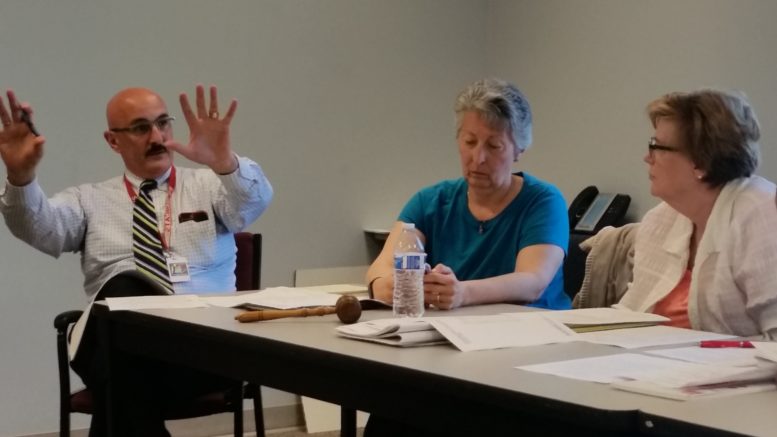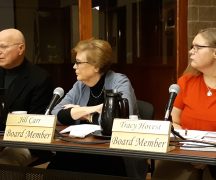By JAN LARSON McLAUGHLIN
BG Independent News
Bowling Green Board of Education took a leap Friday afternoon to invest $72 million in a consolidated elementary and new sections for the high school. The board is now hoping the voters follow their lead.
After months of discussions and public meetings, the board voted 4 to 1 to go ahead with plans for one consolidated elementary, demolition of Conneaut and Kenwood schools, and major additions to the high school. The vote against the project came from board president Ellen Scholl, who supported an alternate plan for new Conneaut and Kenwood elementaries rather than the consolidation.
Though the millage to cover the $72 million project has yet to be determined by the county auditor, it is estimated it could be close to 6 mills on the November ballot.
If the issue is approved by voters, the new consolidated elementary planned north of the current middle and high schools, could be completed by the summer of 2020. The high school could be completed by summer of 2021, according to architect Kent Buehrer.
Construction is also planned for the middle school, where a wing will be added to adequately handle the sixth grade class. That project, which will likely begin in September, will be financed through $4.6 million in permanent improvement funds that the district already has, so it will not be part of the bond issue in November.
The three options being considered for the bond issue were:
- Renovations of Conneaut and Kenwood elementaries (Crim was renovated recently) and major high school additions: $54 million.
- Build new Conneaut and Kenwood elementaries, plus the high school additions: $62 million.
- Build one consolidated elementary, plus the high school additions: $72 million.
The renovation option was discarded first, since the 55-year-old elementaries don’t have particularly good “bones,” Buehrer said. Renovating those buildings would be “throwing new money” into old structures not worth the investment, board member Jill Carr said.
Superintendent Francis Scruci talked about the benefits of a consolidated elementary.
“It puts all our resources in one facility” and allows for optimum collaboration by teachers, he said. The elementary would have 1,500 children, but there would be separate wings for kindergarten and first graders, another for second and third graders, and another for fourth and fifth graders.
“They don’t interact unless it’s by design,” Scruci said.
The consolidation would also allow for the Crim building to be repurposed for administration, an expanded preschool program and an autism program.

School board and treasurer
Kenwood kindergarten teacher Kisha Nichols read from a letter signed by several teachers at her building. She noted the strong support of teachers district wide for the centralized building. She told of children having to wear coats in school because the heat doesn’t work properly, and of suspicions that air quality and mold have led to student and staff sickness.
Nichols also noted the uneven class sizes that will be remedied by consolidation. And she talked about the divisions between the three elementaries that seem to be worsening.
“We’ll finally all be Bobcats,” she said.
High school teacher Jeff Nichols encouraged the school board to be bold.
“I think we have an opportunity to do something great in this district,” he said.
Nichols said he can understand residents’ attachments to their neighborhood elementary schools. However, those schools do nothing to encourage people to move to Bowling Green.
“That’s a good looking school, we want to move that to district,” he said of reactions to other districts. “But we don’t have that drive-by effect.”
Bowling Green has great teachers and great administrators – who help turn out great students.
“Now we need a facility to go with it,” Nichols said.
High school principal Jeff Dever agreed that Bowling Green schools don’t stand a chance with the drive-bys. “
“They decide on other schools only because of the curb appeal,” Dever said.
“We think we have a pretty good product,” with lower property taxes than most districts in Wood County, he added.
Dever also agreed with the climate assessment at the high school. He invited anyone to stop by the high school after classes start in mid-August. “You tell me if that’s educationally appropriate.”
One citizen spoke against the project, suggesting that the board look closer at school finances.
“I can’t say a new school is going to bring people into this district,” Bud Henschen said. But a new school will increase taxes, making houses unaffordable, he said.
“You’ve got to look at the bucks,” Henschen said. “There’s a difference between need and desire.”
But retired teacher Diane Vogtsberger disagreed.
“They are the ones who will retain our property values,” she said of students educated in the new schools. “I think it’s time to look forward and not look back to the past. I personally think the consolidation is the right way to go.”
Realtor Sandy Rowland agreed, saying property values in Northwest Ohio are contingent upon the quality of schools.
If higher taxes drove people away, then the Perrysburg and Anthony Wayne school districts wouldn’t be the “hot spots” they are, she said.
“The quality of schools dictates home prices,” Rowland said. “Bowling Green is losing population.”
Ann McCarthy, the district’s executive director of teaching and learning, said a consolidated elementary would give children educational equity, “regardless of where they are from.” Crim Principal Melanie Garbig noted the “emotional mess” that occurred when the district had to redistrict the elementaries and some children were moved from Conneaut to Crim.
One centralized elementary would erase those lines
“It’s the right thing for us to do. It’s the equitable thing to do,” Garbig said.
The majority of the board agreed, with Jill Carr, Bill Clifford, Ginny Stewart and Paul Walker voting for the consolidation plan. Clifford referred to the project as a “lifetime opportunity” for the schools and the community.
But Ellen Scholl voted against the project, saying it was “too large” for the 1,500 elementary students who would go there, and for the citizens who will have to pay for it. She said the consolidation was a “mistake” and suggested that the district find other ways to collaborate.
Scholl’s biggest concern is for the average child – not the special needs, the super smart or the trouble makers. Those children will still get the attention. But the average kids could get lost in the hugeness of the school. “Nobody’s going to really know them.”
She also voiced concern about the project being so expensive that the district will need special permission from the state to seek bonds for the $72 million. She talked about the more than 40 percent of students who qualify for free lunches in the district. “Their parents can’t afford to feed them now,” she said.
But following the vote, Scholl said she will support the board’s decision. “I will be behind it 100 percent,” she said.
Scruci said he was not worried by the split vote, and that he appreciated the honesty of the board. “We have board members who stick to their convictions. It certainly takes a lot of courage.”





